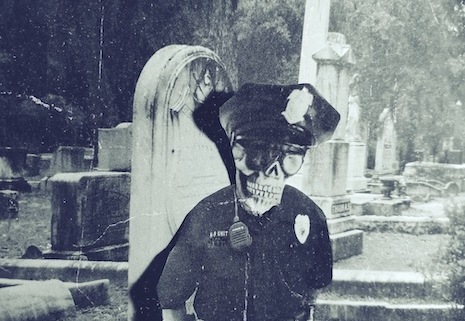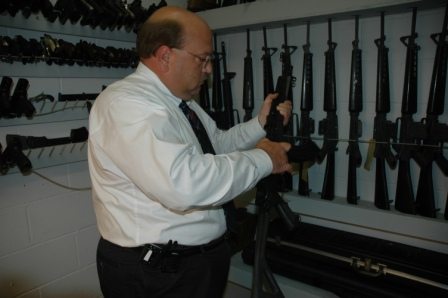Writers are hard workers.
It’s not an easy task to reach into the brain to pull out and assemble just enough details from the swirling mass of ideas located there in order to create an entire world along with a bunch of individual characters whose job it is to entertain and hold the attention of devoted readers as they travel through your imaginary setting, one page at a time (how’s this for a run-on sentence?).
I’ve seen the amount of work that goes into writing a book, and I know writers spend a lot of time researching cops, private investigators, detectives, CSI techs, state police, sheriffs’ deputies, and federal agents. Lots of time.
A great deal of a crime/cop writer’s valuable time and energy is devoted to participating in citizens police academies, attending the Writers’ Police Academy, emailing cops and former cops, visiting police stations, and reading blogs, such as this one.
The results of the hard work are obvious, and I applaud them for their dedication to the craft. They, the hard working writers, want their details to be accurate, and they want their tall tales to be fantastic, maybe even perfect.
So why do we still see books with cop facts that are totally and absolutely wrong?
Some writers devote tons of time to the finest of finite crime scene details, but not a single second goes toward the accuracy of other aspects of the story. Yes, it’s true. Some writers pick and choose which facts to feature with precision, leaving other “stuff” to fend for itself, meaning the book is a hodgepodge of solid realism mixed with sloppy carelessness. Trust me, the laziness always bleeds through the text.
Selective Research
I know, some things are more fun and/or more interesting to research. Therefore, it’s quite easy to focus some, most, or all of the attention on the cool stuff, the stuff that tickles the writer’s own fancy. As a result, there’s no time for the other details that may be a reader’s fancy-tickler.
Another hazard of conducting selective research is that it could cause a writer to spend a ton of time on just the details of interest to them, resulting in a rush job of the not-so-fun elements of the story. Of course, as we all know, a hurried approach can and often does result in unfortunate innacuracies.
Guns and Cops
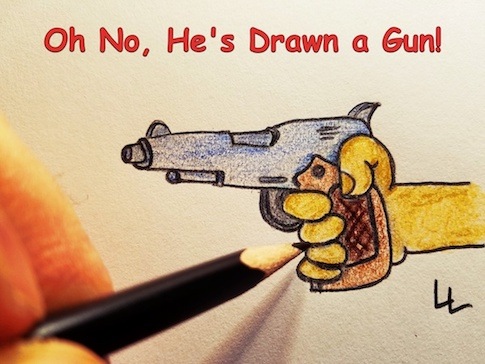
I could easily settle into a long rant about the firearms, shooting, and ammunition errors I sometimes read in books written by various authors, but I’ll refrain from the foot stomping tantrum and opt for the usual presenting of facts (below).
In addition to gun inaccuracies, a great example of selective research is how small town cops are portrayed in some books. They’re often presented as totally and unbelievably dumb. S.T.U.P.I.D.
To those people who aren’t aware, and apparently there are more than a few, being from or working in a small town does not cause ignorance. Nor does it mean the only way the town’s officer got the job is because no one else wanted it.
Like people who long to become writers, lawyers, doctors, educators, plumbers, electricians, landscapers, etc., there are people who actually do dream of becoming police officers, and many of those people are from small towns. You know, just like many doctors and lawyers are from small towns.
To suggest that officers in small towns are inferior humans is highly offensive to small town police everywhere.
Small Town Cops are Hillbilly Racist Rednecks
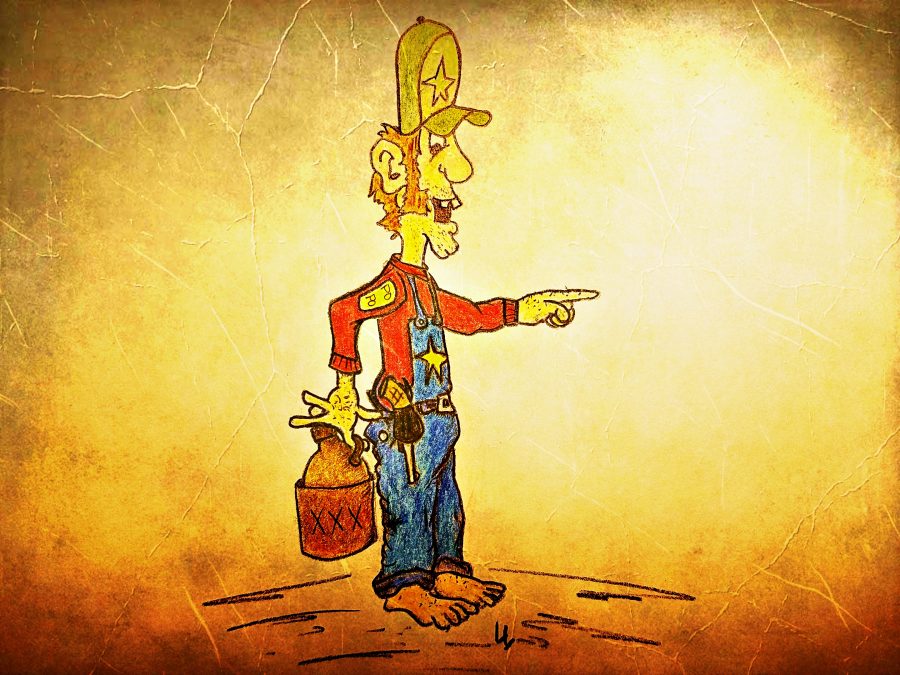
Cap’n Rufus “Peanut” Jenkins
Let’s explore a bit further by leading with a question. Why do some writers think it’s okay/not offensive to write all officers who live in the south as hillbilly racist rednecks? I saw this today, again, in fact.
Or that cops are fat, ignorant slobs who can barely dress themselves because they always have a donut in one hand and a bottle of whiskey in the other. Yes, this stuff is highly offensive, but it seems to be okay to write as long as it’s about cops from the south, or sometimes cops in general. Actually, writing this stuff shows a complete lack of knowledge and understanding of the good people of the south. Again, Selective Research.
And, I won’t jump on the cordite bandwagon again (No, No, and NO cordite!).
Firearms Terminology in Crime Novels
For now, let’s get back on track and address some of the firearms terminology I often see in crime novels. And, that’s where some of the trouble begins. Starting with …
Automatic v. Semi-Automatic
Both types of firearms, the autos and the semi-autos, reload automatically, hence the “auto” label that’s included in the name. Duh.
However, the difference between the two is huge.
- Semi-automatic – The shooter must pull the trigger each time he or she wishes the gun to fire.This is not a machine gun. These weapons do not “spray” gunfire at the speed of light. Included in this group of firearms are the typical AK-47 and AR-15 owned by many people in the U.S. Also, in this group are pistols such as the Glock, SIG Sauer, Ruger, Smith and Wesson, Colt, etc. They are the pistols carried by most gun-owning citizens and police officers. Again, these are not automatic weapons.
- Automatic Weapons – If the shooter continues to depress the trigger, without letting go, the gun fire indefinitely until it is out of ammunition. This is a machine gun, an automatic.
I repeat, the main difference between a semi-automatic and a fully-automatic machine gun is that when using a semi-automatic, the user must pull the trigger each time he or she wishes the gun to fire. As long as the shooter depresses the trigger and holds it in place, a fully automatic gun continues to fire until either there are no bullets left in the magazine and chamber, or when he/she releases the trigger.
Please, writers, make note of the distinction and functionality of the two weapons. A semi-auto is NOT an automatic. The pistol carried by your local police detective is NOT an automatic.
I point out this difference between these two firearm types today because I nearly tossed my Kindle outside this week when I read a recent release by a super-famous, household-name author whose characters carried and fired “automatic” pistols. The terminology, of course, should’ve been semi-automatic. Again, cops don’t carry automatic pistols and writers truly should conduct a bit of research no matter how famous they become.
The book mentioned above was superbly written, by the way. As always, the author had the uncanny ability of inviting and welcoming the reader to step into a world they’d created. The settings itself was a living breathing character. It was a pleasure to allow myself to begin the journey.
I read each night before I go to sleep and I found myself anxious to pick up this book (on Kindle) to continue the trek. However, this wonderful tale began to crumble near the end. It seemed as if the author had either lost their train of thought or had someone else write the final chapters. Even the voice changed ever so slightly, but the change was noticeable. I’d love to know if others sensed the transformation.
Then came the firearm errors along with a couple of oddly placed mentions of todays politics, mentions that weren’t needed to further the story. Actually, it felt as if the writer suddenly remembered they’d intended to insert politics so they went back to a completed story and inserted the stuff at random places. At that point (the bad gun information and politics) I was done. A perfectly fine book suddenly took a sour turn. Sadly, I felt as if I’d wasted a few hours of my life.
Anyway …
The Machine Gun, an Automatic Firearm
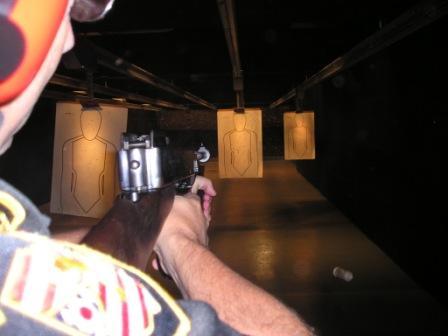
This is what it looks like to peer down-range from behind a Thompson fully-automatic submachine gun. You can actually see a spent cartridge ejecting at the lower right-hand side of the picture, just above the major’s right elbow.
The Thompson is an extremely heavy weapon that’s capable of firing 900 rounds of .45 caliber ammunition per minute, and let me tell you, that’s fast. The experience of firing one of these babies is like no other. I took this photo and was peppered with gunpowder during each burst of gunfire, even from the distance where I stood, which was as you see it. I didn’t use the zoom. We took this shot in a controlled situation while wearing full protective gear and employing other safety precautions. I say this because I don’t recommend this method of photography. It’s not safe. Gee, the things writers do for book and blog article research.
The Thompson was extremely popular in the 1920s among both law enforcement and gangsters alike. The notorious John Dillinger and his gang amassed an arsenal of these “Chicago Typewriters.” The FBI and other agencies, such as the NYPD, also put Tommy Guns to use in their efforts to battle crime. In fact, the weapon became so popular in law enforcement circles it earned another nickname, The Anti-Bandit Gun.
Shotgun v. Rifle

Snipers use rifles, not shotguns.
I see these two used interchangeably, and they’re not. Not even close. Yes, they’re both considered long guns, but a rifle has a barrel with interior spiraled grooves that cause the projectile (bullet) to spin (think of a football thrown by a quarterback). The spinning increases accuracy and the distance the round can travel. Normally, shotgun barrels are not rifled.
Snipers use rifles, not shotguns.
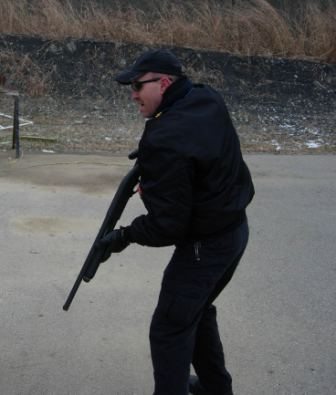
Officers typically make use of shotguns at distances of 75 yards and less (distances vary).
A shotgun has a smooth barrel that’s designed to fire a shell containing several small pellets called “shot.” When fired, the shot spread out allowing a greater chance of hitting a target. However, a shotgun is basically accurate at closer distances. But, hitting a moving target, or smaller targets, is much easier with a shotgun than with a rifle.
Of course, there are over-and-under long guns that feature two barrels, one above the other. One of the two barrels is a shotgun barrel. The other is a rifle barrel. Therefore, an over-and-under of this type is both a shotgun and a rifle!
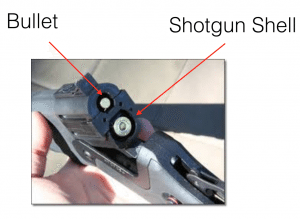
Top barrel is rifle. Bottom barrel is shotgun.
To go one step further …

Handguns vs. Firearms vs. Pistols vs. Revolvers
I might create a little buzz with this one, but yes, there’s a difference between a pistol and revolver. A revolver is a handgun with a rotating cylinder that feeds ammunition, one bullet at a time, to its proper firing position each time the trigger is pulled. A revolver is a handgun, and it is a firearm.
A handgun, such as the Glock or Sig Sauer, is actually a semi-automatic pistol. Ammunition is fed to the firing position by a spring-loaded magazine. A pistol is also a firearm.
I know, the NRA uses a slightly different set of terms. For the purpose of cops and guns, and federal law and terminologies, though, we’ll stick to ATF’s definitions and explanations.
Clip vs. Magazine
It’s a magazine that’s loaded with bullets and inserted into the pistol carried by your protagonists. A clip is actually something that stores ammunition and refills magazines. So please don’t confuse the two. Officers do not shove a fresh “clip” into their pistol when reloading. Magazine, magazine, magazine!
Ammunition
One round of ammunition is a cartridge.
Typically, pistols, revolvers, and rifles do not fire shells (there are a few exceptions).
So, silly writer, shells are for shotguns …

Or the beach …

Pistol v. Revolver
The images and information below are from ATF’s website.
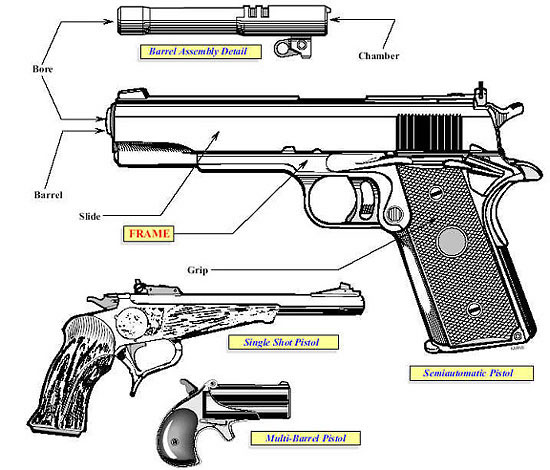
Pistol (semi-automatic)
The term “Pistol” means a weapon originally designed, made, and intended to fire a projectile (bullet) from one or more barrels when held in one hand, and having:
- a chamber(s) as an integral part(s) of, or permanently aligned with, the bore(s);
- and a short stock designed to be gripped by one hand at an angle to and extending below the line of the bore(s).
Pistol nomenclature (below)
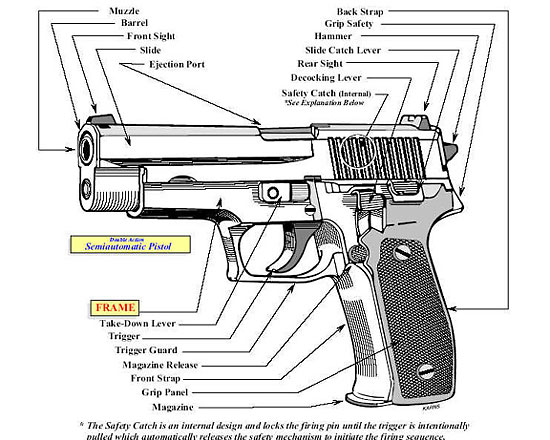
Revolver
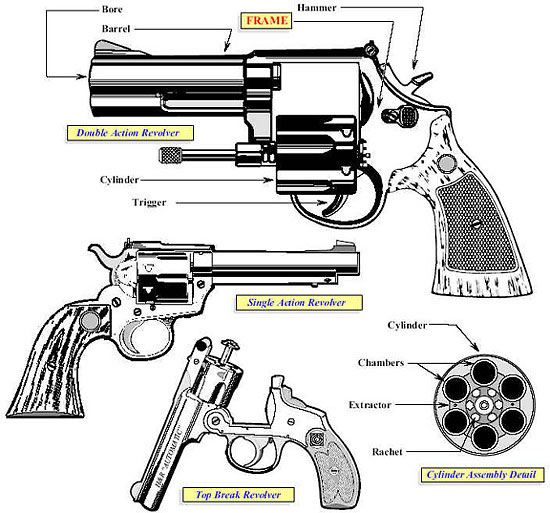
The term “Revolver” means a projectile weapon of the pistol type, having a breechloading chambered cylinder so arranged that the cocking of the hammer or movement of the trigger rotates it and brings the next cartridge in line with the barrel for firing.
Revolver nomenclature (below)
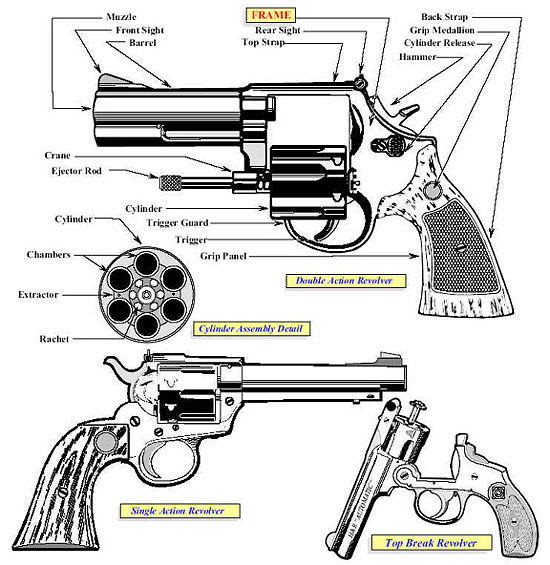
*All of the above (nomenclature text and images) are from ATF (Alcohol, Tobacco, Firearms, and Explosives). Thanks to the folks at ATF for allowing the reproduction and use.
For Writers: Semi-autos and fully automatic (machine guns) automatically eject spent cartridges. Revolvers DO NOT. Therefore, writers, chances are slim and mostly none of finding empty revolver cartridges at a crime scene. Please remember this when writing the “aha” moment in your WIP.
Important Notice!!
As always, I highly recommend presenting your questions to a qualified expert, not the brother of a brother’s sister’s cousin’s third wife’s hairdresser’s neighbor’s son’s father who lives next door to a guy who once saw a cop walking along the sidewalk. And, someone who merely reads something about a law enforcement topic and then relays the information to you, well, this is not the best method of conducting research. Reading a chapter in a book does not make your barber an expert on police procedure and/or forensics.
So please, please, please, speak with law enforcement professionals about the desired cop-stuff. After all, you wouldn’t ask a cop to diagnose the poor condition of your lawn, right? So why ask a landscaper about police procedure, even if her advice comes straight from my book on police procedure. Why not? Because sometimes people, even those with the best of intentions can misread and/or misspeak, and then it is your work and your reputation that suffers for the mistake of someone else.
The best solution, of course, is to attend the Writers’ Police Academy, where you learn by participating in actual hands-on police training, such as shooting, driving, fingerprinting, evidence collection, and homicide investigation.


